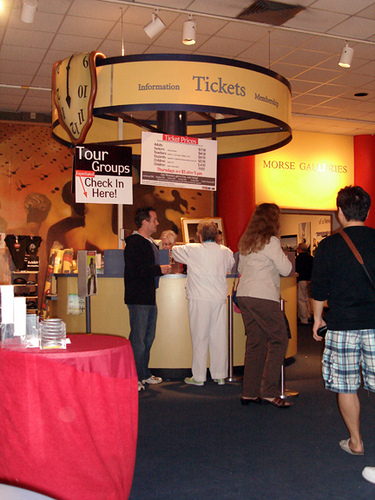
To fee or not to fee: $25, $19.50, $23, $20, $25, $25, $22, $19.50, $20. Those are the regular admission charges for adults at, in order, the Metropolitan Museum of Art in New York, the Seattle Art Museum, the Art Institute of Chicago, the Philadelphia Museum of Art, the Museum of Modern Art in New York, the Boston Museum of Fine Art, the Guggenheim Museum in New York, the High Museum in Atlanta, and the Frick Art Museum in New York. If someone told me I could visit those nine museums for $199 I would probably consider it a bargain; the treasures they hold and have to maintain are well worth the price of a mid-sized TV.
But consider this: the permanent collections of the following art museums are free every day — the Cleveland Museum of Art, the National Gallery of Art in Washington, the St. Louis Museum of Art, the Dallas Museum of Art, the Minneapolis Institute of Arts, the Joslyn Museum in Omaha, the Getty Center in Los Angeles, the Kimbell Art Museum in Fort Worth, the Indianapolis Museum of Art, the Hirshhorn Museum of Modern Art in Washington, and the Toledo Museum of Art, among others. And, just for fiscal comparison, you can visit the Detroit Institute of Art for $8, the Portland (OR) Museum of Art for $15, the Denver Art Museum for $13, the Milwaukee Art Museum for $17, the Norton Simon Museum in Pasadena for $10, the Walker Art Center in Minneapolis for $12, the Phillips Collection in Washington for $12, the Los Angeles County Museum of Art for $15, the Carnegie Museum in Pittsburgh for $17.95, and the Houston Museum of Fine Art for $15. (If you go to Pittsburgh, I suggest you tell them to just keep the nickel.)
Perhaps I’ve saved you the time from googling all this data, and let’s be fair and add a few disclaimers. The above museums all offer reduced admission to populations such as children and seniors, and some shave a few dollars off for local residents and students, while others have a free day or evening. Some include special exhibitions in their regular admission fee, some do not, and almost all provide special rates to school groups and the like. Some of these museums are owned by their cities or are private institutions; others are not-for-profit or run by foundations. And a further disclaimer about the Met: it’s only now attempting to change its pay-what-you-like-but-you-must-pay-something policy, which came with a “recommended admission” of $25, to a mandatory $25 admission fee for adults. Many other museums, the Art Institute of Chicago, for example, have done the same. What was once a suggested admission has almost universally become a required fee. (The Met found that despite signage requesting the $25 recommended adult admission, their average entrance ticket sold for around $11.)
Now, what all this might mean is something else altogether — all of us understand the need of a museum to generate income. The Met draws around 6 million visitors a year; if all are adults and pay the full admission fee, the Met clears $150 million, not including the sale of Monet umbrellas from the gift shop. But the National Gallery in Washington draws around 4.2 million people a year, from which it clears $0. They both have a building as well as a collection to maintain, staff who require and deserve salaries, exhibitions that are often very costly to mount, and acquisitions they’d like to make.
Many of the museums cited at the beginning of this column were free when they opened a century or so ago. In those days art museums were considered akin to parks and public libraries: a civic right, always free at the point of entry. And like parks and libraries, art museums were funded by their communities in the democratic belief that cultural riches were not just the property of the wealthy, but should be made accessible to all. They still seem to think so in Cleveland, Fort Worth, St. Louis, etc. Not so much in Denver, Milwaukee, Philadelphia, etc.
Is it a good thing that a family of four might need as much as $100 just to walk into MOMA? Entry fees of this magnitude certainly keep the poor out — gee, you don’t think that’s part of these fees intention, do you? They are also a disincentive for the casual museum-goer, the man or woman who likes to run into their local art museum for 30 or 45 minutes just to look at a few things. It makes going to the museum not a spur of the moment act, but something that has to be planned for. You certainly are going to want to get your money’s worth, and what was once a leisurely stroll becomes more like a forced march for value. All in all, this seems a worrisome trend, and Cleveland has never looked so good.
